Read the latest insights and information on the Australian cattle market for November 2025*.
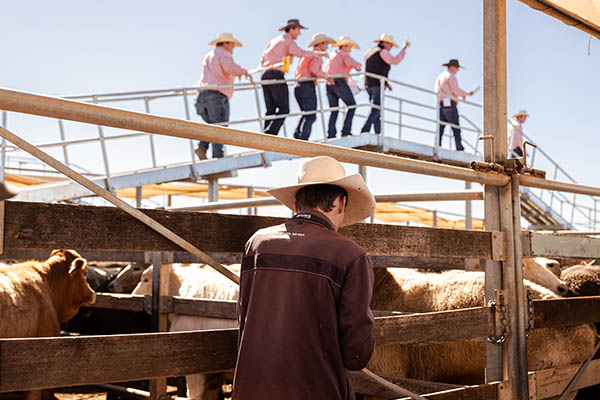
Lift in seasonal confidence sees cattle prices recover
After dipping briefly during October as spring weather turned hot and dry and turnoff increased, cattle markets have recovered as storms and rain have brought relief to graziers across the eastern seaboard.
Seasonal confidence is gradually building with a change in the weather pattern and the move of the high-pressure system out of the Bight, which will allow tropical moisture to feed down from the top-end across the eastern seaboard south-east Australia. This will lift the prospect of a strong northern wet season and unseasonal summer rain for the south-east.
Slaughter cattle supply has begun to taper off as the northern season winds down and with the lack of slaughter weight cattle in the south, given the uneven spring. Southern processors remain active in northern markets, but Queensland processors have upped the ante pushing heavy steer and cow bids to $4.40 to 4.60c/kg lw as they seek to secure dwindling supplies leading into their seasonal shutdown.
Feedlots which were well supplied with cattle being moving off oats a month ago are struggling to source suitable cattle with some producers opting to hang onto cattle after prices dipped. Feeder rates have lifted rates again as feedlots compete to attract feeder cattle away from restockers
Restocker cattle values have been the most volatile through spring as confidence waxed and waned with changes in the weather. In Victoria, those that were sellers a month ago are now buyers with late spring rain and more forecast, illustrating the fickle nature of restocker demand across the south after two poor seasons, tight cash flows and higher restocker cattle values.
On the live cattle front, regular storms have disrupted pastoral cattle movements across the north and with more rain in nearby forecast it could signal the end of pastoral cattle supplies out of the north for the year. With Indonesian feedlots looking to complete buying ahead of their peak demand period around religious festivals early next year, exporters have turned to the Darwin floodplain to secure supply. Prices for light and medium weight Brahman feeder cattle suitable for Indonesia have risen by $1/kg lw in the past couple of months to $4.40 to 4.60/kg lw ex Darwin with exporters nervous about availability out of Townsville where $4.20c/kg lw may not be sufficient to source enough cattle, given the strength of southern feeder markets.
Trade policy changes look to be the major threat to export demand for Australian beef
Solid demand for Australian beef exports from north America and China continue to underpin Australian cattle prices. While this looks set to continue, changes in trade policy have the potential to disrupt current trade flows and affect prices for Australian beef in export markets.
Recently China and the US appear to have called a truce and while there has been no immediate impact on the imported beef market in China, there will be pressure from the US Government for China to restate export permits for US beef export processors. A lift in US competition in China could take the gloss off Australian beef export prices in China.
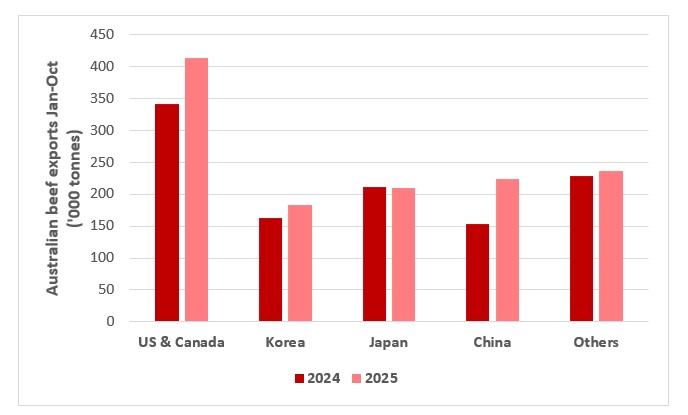 This chart shows Australian beef exports by destination for January to October. Source: DAFF.
This chart shows Australian beef exports by destination for January to October. Source: DAFF.
The US market is at an interesting juncture. Imported beef prices continued to rise in the past month. With Australia now the only major source of imported volume, buyers are prepared to pay close to US domestic prices for imported product, with the flexibility to schedule delivery two to four months out and without the cost to box, freeze and store it.
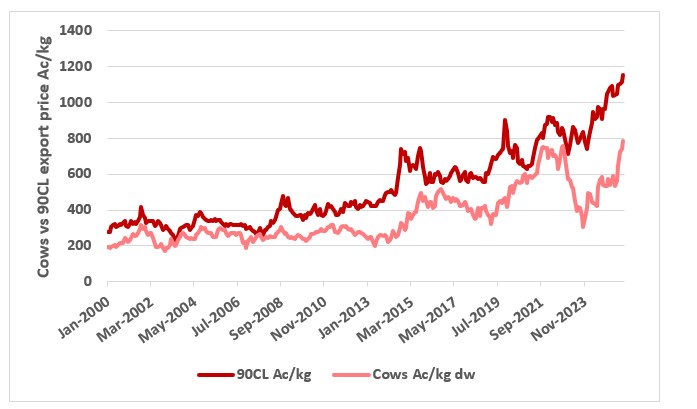 Australian 90CL beef export prices vs the national saleyard cow indicator. Source: MLA.
Australian 90CL beef export prices vs the national saleyard cow indicator. Source: MLA.
However, US import policies are adding uncertainty to trading conditions. In recent weeks Trump has increased Argentine beef access to the US four-fold to 80,000t, while there is increasing pressure on the US Government from importers to reduce the Brazilian beef tariff and allow increased Brazilian beef imports as a measure to reduce the cost of living.
In addition, the lawfulness of Trump’s tariff regime is currently being challenged in the US Supreme Court. As to when a decision may come, it could be as late as June next year or as early as December. If the tariffs are suspended, it could result in a rush of shipments. The effect has been to inject more uncertainty for the trade.
Tightening supplies aid heavy cattle values
The other major threat to current pricing levels for Australian beef and cattle is a slowdown in US grainfed beef demand.
US beef grainfed prices (current price) and feeder cattle (indicator of forward prices) values have begun to move in opposite directions as concerns grow about the future strength of US beef demand given budgetary cuts to food welfare payments, persistent signs of weak consumer sentiment and increasing discord about costing of living pressures. Noting this caution, US futures markets have fed cattle prices easing 10 per cent (pc) in deferred positions.
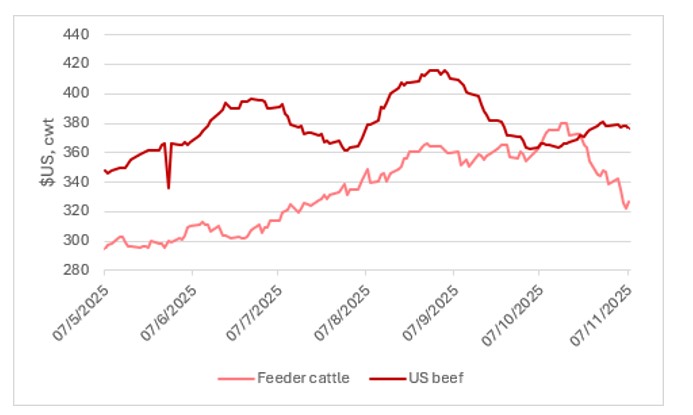 This chart shows US feeder cattle prices and US beef cut-out prices (grain-fed beef). Source: LSEG Workstation.
This chart shows US feeder cattle prices and US beef cut-out prices (grain-fed beef). Source: LSEG Workstation.
Given the importance of the US market (over 30 pc of our beef exports), any significant weakening of demand for beef in the US will have price implications.
Tight heavy cattle supplies and firm demand support local prices
An early start to the northern wet season and a tight spring across the south has combined to tighten available supplies of heavy cattle. This has contributed to the quick rebound in heavy cattle values during November.
With beef processing margins remaining strong, local processors have had to compete harder to source cattle to maintain kills. In a sign of the strong processing environment a major southern QLD processor has recently introduced another permanent processing shift, increasing its capacity by 1,600 head to 14,400 per week. Other Queensland plants have also reportedly begun working additional shifts to clear the backlog of Queensland slaughter cattle ahead of the seasonal shutdown in mid-December.
Local processors expand kills
In a sign of the strong profitability being enjoyed across the northern processing sector, several Queensland plants have expanded slaughter capacity in recent weeks.
This has seen them compete harder against southern processors for supply and has allowed a quick rebound in local heavy cattle prices.
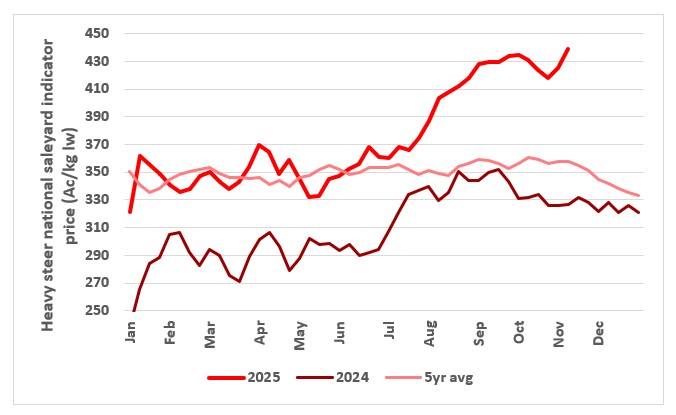 This chart shows the c/kg lw national saleyard indicator price for heavy steers in 2024, 2025 and the five year average. Source: MLA
This chart shows the c/kg lw national saleyard indicator price for heavy steers in 2024, 2025 and the five year average. Source: MLA
Cow values rise as northern supply slows and US lean beef demand firms
Steiner reports US imported 90CL (a measure of fat content, meaning 90 pc chemical lean) beef prices have firmed (+40Ac/kg) over the past month to be only a couple of cents below the quoted price for US domestic fresh product. The average imported discount narrowed to about 7USc/lb (cents per pound) below US domestic fresh (this discount has been consistently around 30USc/lb for much of the year).
The narrowing discount largely reflects slower imports from South America. It’s also typical for imported 90CL beef to trade close to US domestic prices during the October to December period. Imports from New Zealand are limited until December, while US domestic cow meat supplies increase as they commence their autumn cow cull.
Higher prices for Australian lean beef in the US and a seasonal slowing in availability of local slaughter cows has underpinned a recovery in cow values the past fortnight.
Cow prices find another level
Increased returns from global grinding beef markets and a tightening in supply of local cows as seasonal conditions improve has seen local cow prices move to another level the past few weeks.
With southern producers looking to retain and restock, processors will need to compete harder for slaughter cows.
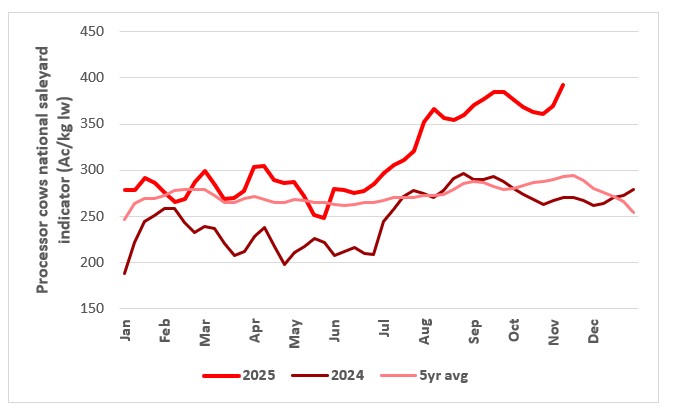 This chart shows the c/kg lw national saleyard indicator price for cows 2024, 2025 and the five year average. Source: MLA
This chart shows the c/kg lw national saleyard indicator price for cows 2024, 2025 and the five year average. Source: MLA
Feeder prices stabilise as final run of northern cattle hit market
Feedlots which were well supplied with cattle being moving off oats a month ago, have lifted rates again as supplies tightened, with some producers opting to hang onto cattle after prices dipped.
In contrast to most years, the feeling is that prices may grind higher into year’s end as good feeding margins have feedlots keen to secure supply and maintain high rates of capacity utilisation. Prices for Angus feeders $5 to $5.10c/kg liveweight (lw), Angus cross $4.80 to $5/kg lw, flatbacks $4.80/kg lw Downs feedlots and domestic feeders heifers $4.40 to $4.50c/kg lw have stabilised at just below their September to October peaks with the prospects of further gains heading into year’s end.
Feeder supplies tighten
Feeder rates have moved back towards earlier levels as supplies tighten with the improvement in seasonal conditions with the prospects for further improvement into year’s end strong given solid feeding margins.
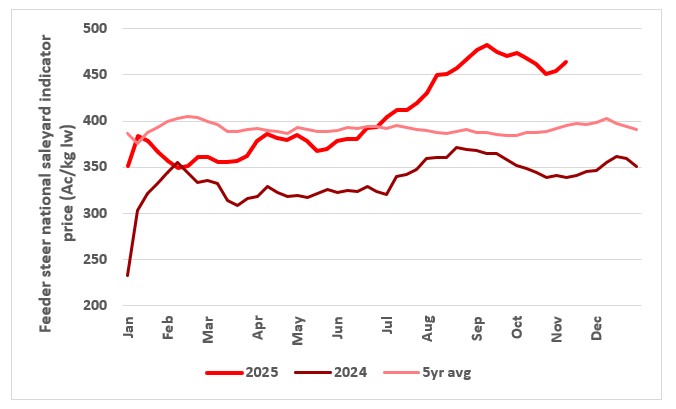 This chart shows c/kg lw national saleyard indicator price for feeder steers in 2024, 2025 and the five year average. Source: MLA
This chart shows c/kg lw national saleyard indicator price for feeder steers in 2024, 2025 and the five year average. Source: MLA
Restocker activity hesitant as higher prices and uncertain seasonal conditions slow appetite
Recent rain and the change in the weather pattern has seen a dramatic shift in restocker confidence. Those who had planned to sell lighter, autumn-drop calves which had struggled through the winter, may now hold them over into the new year.
Until the end of October, the season for many across the south had been in balance but recent rain has taken a lot of pressure off the immediate need to turnoff cattle. Calves with good frame that had done it tough through the winter could now pack on weight with the rain improving pastures markedly.
While there remain areas that are tight (NSW Monaro, Riverina and south-west and the SA/Victorian Mallee), conditions across the southern and eastern Victoria and SA are the best in two years.
South moves towards restocking
Rain in November and a change in the weather pattern has seen some southern graziers who were sellers a month ago start to become buyers of lighter cattle with some calve sales reaching $6 to 7c/kg lw in recent weeks.
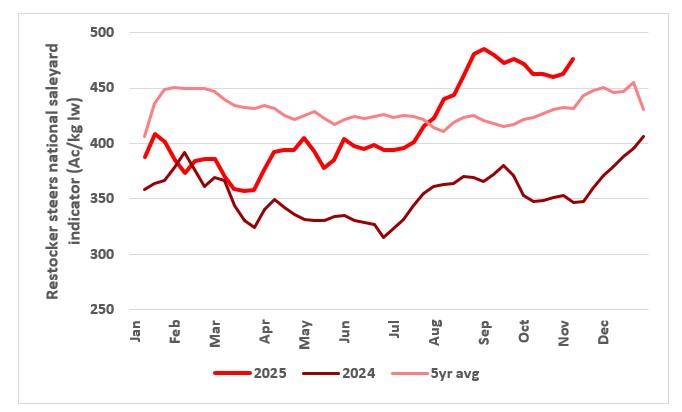 This chart shows c/kg lw national saleyard indicator price for restocker steers in 2024, 2025 and the five year average. Source: MLA
This chart shows c/kg lw national saleyard indicator price for restocker steers in 2024, 2025 and the five year average. Source: MLA
Building restocker confidence to support heifer values
Heifer values are starting to move higher towards feeder steer values with improved restocker buying. For much of the past couple of years, in the absence of restocker demand, particularly across the south, heifers have carried a hefty 80 to 100c/kg lw discount to steers (reflecting their lower feeding and processing value). This has recent narrowed to around 50c/kg lw as restocker interest has lifted reflecting their value as future breeding stock.
While we are still a fair away from a full rebuild in the south, unseasonal summer rain could spark the heifer market given strong forward prospects for Australian beef and cattle prices. Heifer prices traded at a premium to steers as producers looked to rebuild herds following the drought in 2020/2021.
Seasonal conditions to guide heifer values
Heifer values have waxed and waned through Spring with changes in seasonal prospects.
The heifer discount has narrowed as restocker activity has picked up and will narrow further if conditions lead to a full rebuild across the south.
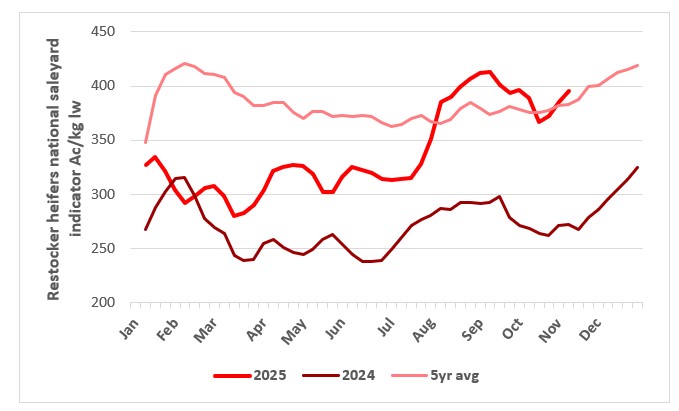 This chart shows c/kg lw national saleyard indicator price for restocker steers in 2024, 2025 and the five year average. Source: MLA.
This chart shows c/kg lw national saleyard indicator price for restocker steers in 2024, 2025 and the five year average. Source: MLA.
From the rails
Read what Elders livestock representatives from around Australia are saying about the markets in their regions.
“The wet season hasn’t started as such but there is storm rain in the north and that's blocking up the general station country. So, the floodplain operators are king. Reports of pricing around $4.70c/kg lw and over Darwin for a Brahman steer 280 to 380 kg off the floodplain and minus 20c/kg lw for a medium steer 380 to 480kg. It's a $1/kg lw dearer than it was only eight weeks ago.
“A few operators are nervous about Townsville supplies. There are several operators actively chasing cattle ex Townsville at about a $4.20/kg lw for Indonesian feeder steers.
“We're unlikely to see a Vietnam boat for the foreseeable future, they were having trouble swallowing steers at $4/kg lw. At the yards in Townsville last week heavy Brahman steers were $4.60/kg lw and a Brahman cow in good order was $4.10/kg lw. So, the job is very, very solid.” - Paul McCormick, Elders Livestock Manager, Customer Solutions.
“Storms around through eastern Queensland last week with falls varying from 10 to 15mm to isolated falls up to 50 to 60mm. Mostly typical storm rain but a little violent in parts, although haven't heard any crop damage out of it.
“We're getting towards the end of our harvest, still see a few chickpeas and stuff around the place that haven't been done, but that's about it.
“Slaughter cattle market strengthened again last week best of your cows $4.20/kg lw and bullocks got to $4.80/kg lw with most around $4.50 to 4.60/kg lw and your domestic kill heifers $4.20 to 4.30/kg lw.
“In the feeder market, in the yards, $4.60 to 4.80/kg lw, but plenty at $4.80/kg lw with the odd $4.90c/kg lw and that heavy trade light 100-day feeders at $5/kg lw.
“We are starting to see the Queensland operators get on top again. We have still got most of the southern operators here, but they're starting to get a bit of competition from these Queensland works.
“This Queensland market with the storms that have been around, there's been enough rain to cause a bit of disruption with supply, and I think our numbers are starting to turn run out a bit” - Ashley Loveday, Elders Livestock Sales Manager, Qld/NT.
QLD saleyard market indicators c/kg lw | ||||
| 12/11/25 | +/- week | +/- month | +/- year |
| Heavy steer | 431 | 423 (+8) | 406 (+25) | 325 (+106) |
| Processor cow | 379 | 367 (+12) | 343 (+36) | 260 (+119) |
| Feeder steer | 479 | 445 (+34) | 458 (+21) | 347 (+132) |
| Restocker steer | 495 | 468 (+27) | 467 (+28) | 363 (+132) |
| Restocker heifer | 417 | 394 (+23) | 387 (+30) | 303 (+114) |
Source: MLA
“About 2 to 3 weeks ago, feeder prices came under a lot of pressure because of volumes of cattle being offered.
“A lot of those southern cattle that came north early in the year had to go as the season had come to an end. Domestic feeder cattle that were making high $4s/kg lw, slipped down to mid-$4s/kg lw.
“Angus steers that were making $5.40 to $5.50/kg lw slipped down to $5/kg lw. But since then, the market has rallied as supply has tightened again. Domestic feeder heifers, $4.40 to 4.50c/kg lw and black steers seem to be at about $5 to 5.10c/kg lw with some upside possible into the end of the year.” - Nik Hannaford, Elders Livestock Manager, Northern Region.
NSW saleyard market indicators c/kg lw | ||||
| 12/11/25 | +/- week | +/- month | +/- year |
Heavy steer | 458 | 453 (+5) | 433 (+25) | 329 (+129) |
Processor cow | 403 | 403 (n/c) | 369 (+34) | 278 (+125) |
Feeder steer | 488 | 479 (+9) | 481 (+7) | 340 (+48) |
Restocker steer | 517 | 493 (+24) | 495 (+22) | 340 (+177) |
Restocker heifer | 451 | 438 (+13) | 436 (+15) | 296 (+155) |
Source: MLA
“Quality is holding up at the yards and numbers are restricted. Seasonal conditions are solid with good late spring rain seeing pasture and feed take-off. Graziers now are looking to hold cattle and add weight and take advantage of feed. Conditions are best they have been in around two years, and optimism has improved with the solid outlook for beef and cattle prices.’
“Offerings are including a good mix of grain fed and grass-fed cattle presented in mostly to excellent condition. The regular buying group were on the rail in a market that had mixed results.
“Young steers to the trade slipped 10c/kg lw while the heifer portion gained 10c/kg lw, feeder and restockers sold firm for the steers and heifers sold 5 to 10c/kg lw stronger. Young cattle sold to the trade $4.32 to 5.18/kg and the plainer types sold to $4.08/kg lw, while feeders made from $3.50 to $4.98/kg lw.
“Grown steers sold to 10c stronger, grown heifers sold to 10c softer selling to $4.42 to $5.10/kg lw to the trade. Grown heifers sold to the trade from $4.20 to 4.82/kg lw, while the plainer lots made to $3.58/kg lw.
“Cows sold to 20c cheaper to the trade. Heavy cows made from $3.86 to 4.58/kg lw, medium weight cows sold from $3.40 to 3.92/kg lw.” - Laryn Gogel, Elders State Livestock Manager – Southern, South Australia.
SA saleyard market indicators c/kg lw | ||||
| 12/11/25 | +/- week | +/- month | +/- year |
Heavy steer | 485 | 470 (+15) | 467 (+18) | 346 (+139) |
Processor cow | 419 | 415 (+4) | 396 (+25) | 269 (+150) |
| Feeder steer | 454 | 457 (-3) | 471 (-17) | 303 (+151) |
Restocker heifer | 439 | 434 (+5) | 437 (+2) | 278 (+161) |
Source: MLA.
“There was a larger yarding of trade and export cattle at Powranna on Tuesday with all cattle meeting a strong market. Yearling steers made $4.22 to $4.40/kg lw, heifers $4.10 to $4.42/kg lw and secondary steers $3.88 to $4.06/kg lw.
“There was an outstanding run of grown steers and bullocks, and they made $4.40 to $4.52/kg lw while crossbreds made $3.80 to $4.10/kg lw.
“The cow market improved 15c to 20c with heavy cows making $4.00 to $4.26/kg while leaner cows made $3.40 to $3.80/kg lw. Heavy bulls made $3.10 to $3.56/kg lw.
“Restocker cattle in strong demand most steers regardless of weight traded between $4.70 to $5.40/kg lw and heifers $4.40 to $5/kg lw.” - Gavin Coombe, State Livestock Manager Tasmania.
TAS saleyard market indicators c/kg lw | ||||
| 12/11/25 | +/- week | +/- month | +/- year |
Heavy steer | 428 | 440 (-12) | 455 (-27) | 269 (+159) |
| Processor cow | 402 | 382 (+20) | 384 (+18) | 230 (+172) |
Source: MLA.
Victoria/Riverina
“More rain here last week, anywhere from sort of 20 to 50mm in Gippsland, even the Riverina got a bit of rain.
“Harvest has started in the Riverina with most of the hay done there. They are now starting to work through northern and central Victoria cutting hay and harvesting crop.
“The south is enjoying the rain still, but there's parts that have probably had enough for now. The recent rain and change in the weather outlook have influenced the livestock market which is getting stronger.
“In southern Victoria there is a tickle of grass fever and in the north the crop is coming off, and some producers are looking for stock to graze on stubbles.” - Nick Gray, Elders State Livestock Manager, Vic/Riverina.
VIC saleyard market indicators c/kg lw | ||||
| 12/11/25 | +/- week | +/- month | +/- year |
| Heavy steer | 472 | 469 (+3) | 478 (-6) | 40 (+132) |
Processor cow | 410 | 420 (-10) | 393 (+17) | 279 (+131) |
Feeder steer | 475 | 466 (+9) | 463 (+12) | 322 (+153) |
Restocker steer | 437 | 458 (-21) | 447 (-10) | 297 (+140) |
| Restocker heifer | 442 | 437 (+5) | 446 (-4) | 300 (+142) |
Source:MLA
“Pastoral cows were yarded in large drafts across all weight ranges and fat scores at Muchea with the last of the pastoral cattle being turned off a little later than normal with the late season in the north, turnoff should mostly be finished by the end of November.”
“Bulls of all weight ranges lifted as did the cow market. Breeding/quality was the main component for gains in both pastoral cattle.
“Cows with more cover gained 10c/kg lw with medium weights making $2.50 to $3.16/kg and heavy cows sold to a top of $3.30/kg lw.
“Competition on shipping bulls was strong, lifting values by 20 to 25c/kg lw making $3.20 to $4.32/kg lw while pastoral heavy bulls lifted 10c/kg lw to equal locally bred bull values with both selling from $2.92 to $3.30/kg lw.
“The first of the WA weaner sales got underway this week at Boyanup. The yarding had more light weight steers than would normally be seen at this time of year, with the expectation that weights will increase from this point on. Weaner steers sold very well to a top of 558c/kg lw in the lightweight Angus offering with medium weights $4.10 to $5.46c/kg lw to average $4.50 to $5/kg lw.
“Angus heifers sold to a top of $5.18/kg lw in the 250 to 300 kg weight category with the average $3.70 to $4.05/kg lw across the various weight classes.” - Michael Longford, Elders Livestock Sales Manager, WA.
WA saleyard market indicators c/kg lw | ||||
| 12/11/25 | +/- week | +/- month | +/- year |
Heavy steer | 379 | 367 (+12) | 361 (+18) | 247 (+132) |
Processor cow | 304 | 294 (+10) | 328 (-24) | 195 (+109) |
Feeder steer | 420 | 418 (+2) | 432 (-12) | 292 (+128) |
Restocker steer | 380 | 408 (-28) | 386 (-6) | 219 (+161) |
Restocker heifer | 368 | 370 (-2) | 365 (+3) | 261 (+107) |
Source: MLA.
*Disclaimer – important, please read:
The information contained in this article is given for general information purposes only, current at the time of first publication, and does not constitute professional advice. The article has been independently created by a human author using some degree of creativity through consultation with various third-party sources. Third party information has been sourced from means which Elders consider to be reliable. However, Elders has not independently verified the information and cannot guarantee its accuracy. Links or references to third party sources are provided for convenience only and do not constitute endorsement of material by third parties or any associated product or service offering. While Elders has exercised reasonable care, skill and diligence in preparation of this article, many factors including environmental/seasonal factors and market conditions can impact its accuracy and currency. The information should not be relied upon under any circumstances and, to the extent permitted by law, Elders disclaim liability for any loss or damage arising out of any reliance upon the information contained in this article. If you would like to speak to someone for tailored advice specific to your circumstances relating to any of the matters referred to in this article, please contact Elders.